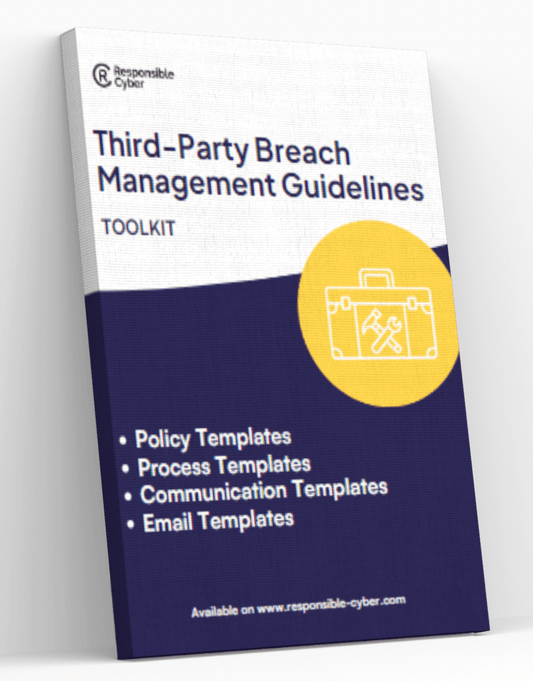Common Mistakes in Third-Party Risk Management and How to Avoid Them

In today's interconnected business landscape, organizations rely heavily on a network of third-party vendors, suppliers, and service providers to support their operations and drive growth. While these third-party relationships offer numerous benefits, they also introduce a myriad of risks that must be effectively managed. Failure to do so can lead to significant financial, reputational, and operational consequences.
As a licensed cybersecurity and risk management company headquartered in Singapore, Responsible Cyber has witnessed firsthand the common pitfalls organizations face in their third-party risk management (TPRM) efforts. Through our expertise and experience, we have identified eight prevalent mistakes that often undermine the effectiveness of TPRM programs, and we are here to share actionable insights on how to avoid them.
Mistake #1: Lack of a Comprehensive TPRM Program
One of the most common mistakes organizations make is the absence of a structured and proactive TPRM program. Instead of taking a holistic and strategic approach, many companies rely on ad-hoc or reactive measures to manage third-party risks. This approach leaves significant gaps in the risk identification, assessment, and mitigation processes, exposing the organization to a wide range of threats.
To address this issue, organizations must establish a comprehensive TPRM program that encompasses the entire lifecycle of third-party relationships, from initial onboarding to ongoing monitoring and offboarding. This program should be aligned with the organization's overall risk management strategy and supported by clear policies, procedures, and governance structures.
Mistake #2: Insufficient Due Diligence
Inadequate due diligence on third-party vendors and suppliers is another prevalent mistake. Organizations often fail to thoroughly assess the risks associated with their third-party partners, leading to the onboarding of high-risk entities or overlooking critical vulnerabilities. This can result in data breaches, compliance violations, service disruptions, and other adverse events.
To mitigate this risk, organizations must implement robust due diligence processes that evaluate a wide range of factors, including financial stability, operational capabilities, cybersecurity posture, regulatory compliance, and reputational history. By conducting comprehensive assessments, organizations can make informed decisions and ensure that their third-party partners are aligned with their risk appetite and business objectives.
Mistake #3: Ineffective Risk Monitoring and Reporting
Ongoing risk monitoring and reporting are essential components of an effective TPRM program, yet many organizations fall short in this area. Failing to continuously assess and report on the evolving risks associated with third-party relationships can lead to blind spots and delayed responses to emerging threats.
To address this challenge, organizations should establish a structured risk monitoring and reporting framework that includes regular assessments, real-time alerts, and comprehensive reporting. This approach allows for the timely identification and mitigation of risks, as well as the ability to demonstrate the effectiveness of the TPRM program to key stakeholders.
Mistake #4: Lack of Third-Party Governance and Accountability
Unclear roles, responsibilities, and accountability within the TPRM process can undermine the effectiveness of risk management efforts. Without a robust governance framework, organizations may struggle to enforce compliance, manage escalations, and hold third-party partners accountable for their performance and risk management practices.
To address this issue, organizations must define and implement a comprehensive governance structure for their TPRM program. This includes establishing clear ownership and accountability for risk management activities, defining escalation protocols, and implementing mechanisms for ongoing performance monitoring and improvement.
Mistake #5: Inadequate Incident Response and Contingency Planning
When a third-party-related incident occurs, organizations must be prepared to respond effectively to minimize the impact on their operations, reputation, and stakeholders. However, many organizations fail to develop and test comprehensive incident response and contingency plans, leaving them vulnerable to prolonged disruptions and potential crises.
To mitigate this risk, organizations should develop and regularly test incident response and business continuity plans that specifically address third-party-related scenarios. These plans should outline clear procedures for incident detection, investigation, escalation, and recovery, as well as strategies for maintaining critical business functions in the event of a third-party disruption.
Mistake #6: Insufficient Training and Awareness
Effective TPRM requires the active participation and engagement of various stakeholders within the organization, including procurement, legal, information security, and risk management teams. However, many organizations neglect to provide adequate training and awareness programs, leading to knowledge gaps and inconsistent risk management practices.
To address this issue, organizations should implement comprehensive training and awareness programs that educate all relevant stakeholders on the importance of TPRM, the organization's policies and procedures, and their individual roles and responsibilities. By fostering a culture of risk awareness and accountability, organizations can enhance the effectiveness of their TPRM efforts.
Mistake #7: Failure to Leverage Technology and Automation
In today's digital landscape, manual processes and spreadsheet-based approaches to TPRM are no longer sufficient to keep pace with the growing complexity and volume of third-party relationships. Organizations that fail to leverage technology and automation solutions often struggle with data management, risk assessment, and reporting challenges.
To overcome this limitation, organizations should invest in purpose-built TPRM technology platforms that enable automated data collection, risk assessment, and monitoring capabilities. By leveraging these solutions, organizations can streamline their TPRM processes, improve data accuracy, and enhance their ability to identify and mitigate risks in a timely and efficient manner.
Mistake #8: Neglecting Regulatory and Compliance Requirements
Regulatory and compliance requirements are a critical consideration in TPRM, as organizations can be held accountable for the actions and failures of their third-party partners. Failing to stay up-to-date with evolving regulations and ensure that third-party partners meet compliance standards can expose the organization to significant legal and financial risks.
To address this challenge, organizations must maintain a comprehensive understanding of the regulatory landscape and incorporate compliance requirements into their TPRM program. This includes conducting regular assessments of third-party partners' compliance posture, implementing controls to ensure adherence, and staying informed of regulatory updates that may impact their third-party relationships.
Conclusion
Effective third-party risk management is essential for organizations to navigate the complex and ever-evolving business landscape. By avoiding the common mistakes outlined in this blog post and implementing best practices, organizations can enhance their resilience, protect their reputation, and unlock the full benefits of their third-party relationships.
At Responsible Cyber, we are committed to empowering organizations with the tools and expertise they need to manage third-party risks effectively. Our IMMUNE X-TPRM and IMMUNE GRC solutions are designed to help our clients overcome the challenges of TPRM and achieve their risk management objectives. Contact us today to learn more about how we can support your organization's TPRM journey.







